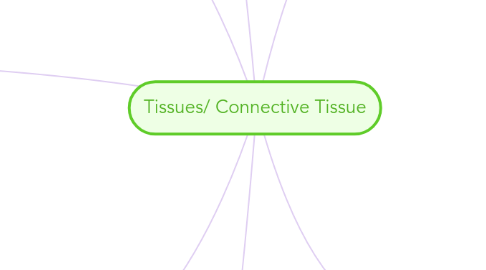
1. ELASTICITY: soft tissue (recoils/rebounds to original length after stretch is released without damage). high collagen content soft tissue (Ligaments and fascia) have small degree of elasticity/pliability
2. Tissue Types
2.1. 1.) muscle tissue: contracts and relaxes
2.2. 2: Nerve Tissue: conducts electrical signal
2.3. 3. Epithelial Tissue: covers surfaces of body and internal cavities
2.4. 4. Connective Tissue: connects, supports, binds, or separates other tissues or organs
3. Connective tissue cont.
3.1. CT cells: Produced by *fibroblasts ( Cells that secrete collagen and ground substance). 1. Osteoblasts (types of fibroblasts that builds bones) 2. Chondroblasts ( fibroblast cell that builds cartilage)
3.2. A. EXTRA CELLULAR MATRIX"Stuff between cells" like A1) COLLAGEN:1/3 of protein in the body, more collagen = more dense and strength. ex: fascia is loose= little collagen. ex: cartilage/tendons/bones are dense=lots of collagen
3.3. A2: Elastin: the more elastin= greater elasticity content
3.4. A3: Reticulin: forms mesh-like frameworks that supports nerves and blood vessels and soft organs (liver, lymph nodes, etc.)
3.5. A4: Ground substance: transparent fluid that hydrates/lubricates cells and fibers
3.6. A5: capillaries, macrophages, adipocytes, etc
4. SOFT TISSUE PROPERTIES (ct tissue minus bone) so basically CT tissue cont...
4.1. STRETCH: Soft tissue (lengthens without being damaged.) *shortened soft tissue is more easily damaged. So its important to lengthen regularly, slowly and gently: to prevent damage.
4.2. PLASTICITY: soft tissue ( retains an altered configuration without damage) when stretched beyond its elastic threshold, but not to its fracture failure point.
4.3. CREEP: soft tissue ( gradually changes in shape when slow, continuous force is applied). commonly seen in postural changes due to gravity.
4.4. THRIXOTROPY: soft tissues can (change their state in response to temperature, pressure). Cold: ground substance becomes thick and viscous (gel-like). Hot: ground substance is thin and watery. (Liquidy)
4.5. TENSILE STRENGTH: soft tissue (can withstand pull in different directions without damage.) is NOT how much the tissue can lengthen, but how much tension the tissue can withstand without failing
4.6. PIEZOELECTRIC EFFECT: soft tissue including bone (produce electric charge when stressed). act as a generator for the tissue response to mechanical stress. The cells produce fibers that align with the direction of stress. Causes ligaments to thicken/ strengthen. Fascia to loosen/tighten
4.7. COLLOIDAL: soft tissue is (flexible and incompressible) the greater fore applied, the greater resistance of the tissue.
5. PURPOSE AND FUNCTION of soft tissue
5.1. Provides mechanical/physical support (bone, cartilage, ligament, tendon, fascia etc.)
5.1.1. Compression tissues (Props) : for weight bearing. EX: BONES CARTILAGE
5.2. Forms structural framework of body
5.2.1. forms cells into tissues, tissues into organs
5.2.2. adheres muscles to bones
5.2.2.1. suspends/supports fat, nerves, blood vessels, lymph vessels
5.2.3. links bones to form joints
5.2.4. envelopes muscle fibers into fascicles into muscles into muscle groups
5.3. Facilitate movement of fluids/ nutrients/ wastes
5.3.1. Tension Tissues ( Suspenders) : 1. Sheets: retinacula, deep fascia, aponuerosis, septa, muscle sheaths. 2. Cables: tendons, ligaments. 3. Soft: superficial fascia, periosteum
5.4. Provides pressurized environment to support internal framework
6. MACKENZIE JOHNSTON
7. Application
7.1. Manual therapy
7.1.1. Relieves adhesions, congestion between connective tissue
7.1.2. rehydrate ground substance
7.1.3. use piezoelectric effect to rehydrate and encourage metabolic exchange
7.2. Force Distribution
7.2.1. Since the connective tissue network is continuous throughout the body, forces are transmitted locally and globally, requiring distant stabilization for every local movement
7.2.2. both internal and external forces are dealt with simultaneously
7.3. "use it or lose it" ROM
8. STRUCTURE
8.1. Liquid:
8.1.1. Plasma; 90% water. ex: blood, lymph, mucus
8.2. Loose:
8.2.1. Collagen production is based on demands of movement
8.2.1.1. Immobility: demands increased production of collagen, to stabilize
8.2.1.2. Mobility: demands absorption of collagen, to allow movement
8.2.2. small number of scattered fibers, large amount of ground substance. ex; adipose tissue, superficial fascia of skin, reticular tissue (supports organs, ducts, glands, bone marrow)
8.3. Dense:
8.3.1. Large number of thick, closely packed fibers, small amount of ground substance. ex: fascia, tendons, ligaments, periosteum, joint capsules
8.4. Cartilaginous:
8.4.1. Fibers and ground substance (chondroitin sulfate)
8.4.1.1. Elastic cartilage: mostly elastin. ex: Eustachian tubes, epiglottis, ear lobes
8.4.1.2. Hyaline cartilage: "Clear/glossy": Thick collagen fibers. ex: nose, ears, trachea
8.4.1.3. Fibrocartilage: Thin collagen fibers, arranged in layers ( makes spongy and shock absorbing) ex: pubic symphysis, intervertebral disks
8.5. Osseous:
8.5.1. collagen fibers and ground substance (Hydroxyapetite, with calcium phosphate salts) Ex: bones

